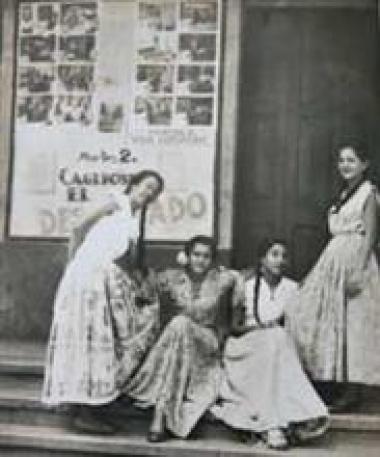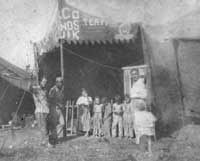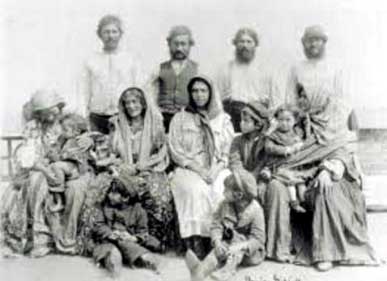In Cuba there are not a great deal of investigation about the arrival of the first Gypsies to the Island, some historian have arrive to the conclusion that the first arrived together with the colonizers, since it was common that the imprisoned gypsies were used to form the crews of the ships that were launched to the New World.
Although its presence on Cuban soil goes back to colonial times, according to historians, the greatest surge came in the wake of World War II, when the Nazis exterminated, in the concentration camps, half a million people belonging to that ethnic group in Central Europe.
Many of them had the intention to use Cuba as a springboard to travel to other countries, but some were integrated, and their descendants found on the island, as they expressed themselves, the only country where they could live in peace.
According to various studies, gypsies or romanies are a people originally from India, although they have migrated to Asia, Africa, America and Europe, a continent where a greater number have been concentrated. Gypsies retain their own language, but often speak more than one language as a result of their nomadic life. Their children, although they are registered in the country that are born with names of that language, carry for the rest of their lives their own gypsy patronym.
Above all love freedom, respect and are faithful to die the head of his tribe. They are extremely superstitious.
Although nomads could be found anywhere in the island participating as artists in the circus, as vendors in fairs and parrandas, or improvising chinchales and timbiriches for the sale of goods made even by themselves, there are documented references that the located, in other times, in some sugar mills such as Chaparra and other regions of eastern Cuba. Also in the province of Las Villas it was common to see their camps, as, for example, on the outskirts of Camajuaní.
In Cuba they left the mark of many of their customs. They spread the fairs, the carnivals, the traveling circus – they came to exist 42. There are words of their language incorporated into the jargon of the composers of the 1940s feeling and the current danceable salsa music … and in the sweets: the arm Gypsy.
In the plastic arts of this period (1925-1940) without a doubt Víctor Manuel García Valdez (1897-1969) with his “Tropical Gitana”, small painting (46 x 38 cm) painted on wood and awarded in the Hall of Painters and Sculptors of 1929, as in other works, represents a mestizo girl, closer to the “gypsy” type than to the Cuban one. Hence its title.
The Spanish spoken in Cuba, as expected, could not escape this “agitator” influence, so in the popular colloquial speech of our country there are many gypsies.
As an example of this, below relate the following: accord (get drunk), andoba (so-and-so), barin (good), watercress (cholera, disgust), swipe (steal), bisnar (sell), de butén (wonder, first), chiva (snitch, informer), chola (head), chota (snitch), rabble (vulgar crowd, coba (flattery, adulation), cumbila (companion, friend), curda (drunkenness, drunkenness), furnia (cave) , gambling house (gambling house), guillarse (pretending to be something different from what one is, being silly), jamar (eating), jarana (joke), face (face), jiña (excrement), chinning (defecating) , jiribilla (salt, grace), mangar (cheat), menda (me), snapper (homosexual), pirabear (fornicate), pirar (leave, go), pure, ra (father, mother), sandunga (donaire, garbo) , surnar (to sleep) …
Once again the veracity of the words of the ethnologist Fernando Ortiz is confirmed when he affirmed that Cuba was an Ajiaco because of the diversity of races and cultures that influenced the formation of his nationality.
Like the Spaniards or the Africans, although to a lesser extent and with less recognition, the gypsies also left us their contribution.
 INFLUENCIA GITANA EN CUBA. GITANISMOS Y HERENCIA.
INFLUENCIA GITANA EN CUBA. GITANISMOS Y HERENCIA.
En Cuba no hay mucha investigación sobre la llegada de los primeros gitanos a la Isla. Algunos historiadores han llegado a la conclusión de que los primeros llegaron junto con los colonizadores, ya que era común que los gitanos encarcelados fueran utilizados para formar las cuadrillas. de los barcos que fueron lanzados al Nuevo Mundo.
Aunque su presencia en tierra cubana se remonte a los tiempos de la colonia, según afirman los historiadores, la mayor oleada llegó a raíz de la II Guerra Mundial, cuando los nazis exterminaron, en los campos de concentración, a medio millón de seres pertenecientes a esa etnia en Europa Central.
Muchos de ellos tenían la intención de utilizar a Cuba como trampolín para viajar a otros países, pero algunos se integraron, y sus descendientes encontraron en la isla, como ellos mismos expresaron, el único país donde podían vivir tranquilos.
Según diversos estudios, los gitanos o romaníes son un pueblo que procede originalmente de la India, aunque ha migrado por Asia, África, América y Europa, continente donde se ha concentrado un mayor número. Los gitanos, conservan su propia lengua, pero en muchas ocasiones hablan más de un idioma como resultado de su vida nómada. Sus hijos, si bien son inscritos en el país que nacen con nombres de esa lengua, llevan por el resto de sus vidas su patronímico propio gitano.
Por encima de todo aman la libertad, respetan y son fieles hasta morir al jefe de su tribu. Son extremadamente supersticiosos.
Aunque por su condición de nómadas se podían encontrar en cualquier lugar de la isla participando como artistas en el circo, como vendedores en ferias y parrandas, o improvisando chinchales y timbiriches para la venta de mercancías elaboradas incluso por ellos mismos, existen referencias documentadas que los ubican, en otros tiempos, en algunos centrales azucareros como el Chaparra y otras regiones del oriente cubano. También en la provincia de Las Villas era frecuente ver sus campamentos, como por ejemplo, a las afueras de Camajuaní.
GITANO’S
En Cuba dejaron la huella de muchas de sus costumbres. Difundieron las ferias, los carnavales, el circo ambulante -llegaron a existir 42. Hay palabras de su lengua incorporadas a la jerga de los compositores del feeling de la década de 1940 y de la actual música bailable salsera… y en los dulces: el brazo gitano.
En las artes plásticas de este período (1925-1940) sin dudas Víctor Manuel García Valdez (1897-1969) con su ”Gitana Tropical”, pequeña pintura (46 x 38 cm) pintada sobre madera y premiada en el Salón de Pintores y Escultores de 1929, al igual que en otras obras, nos representa a una muchacha mestiza, más cercana al tipo “gitana” que a la cubana. De ahí su título.
El español hablado en Cuba, como es de esperar, no pudo escapar a este influjo “agitanador”, por lo que en el habla coloquial popular de nuestro país son numerosos los gitanismos.
Como ejemplo de ello, a continuación relacionamos los siguientes: acurdar (emborrachar) , andoba (fulano), barín (bueno), berro (cólera, disgusto), birlar (robar), bisnar (vender), de butén (de maravilla, de primera), chiva (soplón, delator), chola (cabeza), chota (soplón), chusma (muchedumbre vulgar, coba (halago, adulación), cumbila (compañero, amigo), curda (embriaguez, borrachera), furnia (cueva), garito (casa de juego), guillarse (hacerse pasar por algo distinto de lo que se es, hacerse el tonto), jamar (comer), jarana (broma), jeta (cara), jiña (excremento), jiñar (defecar), jiribilla (salero, gracia), mangar (engañar), menda (yo), pargo (homosexual), pirabear (fornicar), pirar (marcharse, irse), puro,ra (padre, madre), sandunga (donaire, garbo), surnar (dormir)…
Una vez más se confirma la veracidad de las palabras del etnólogo Fernando Ortiz cuando afirmó que Cuba era un ajiaco por la diversidad de razas y culturas que influyeron en la formación de su nacionalidad.
Como los españoles o los africanos, aunque en menor medida y con menos reconocimiento, los gitanos también nos dejaron su aporte.
Agencies/Memoriascubanas/Derubin Jacomé/Internet Photos/ Arnoldo Varona/ Thecubanhistory.com
THE CUBAN HISTORY, HOLLYWOOD.








